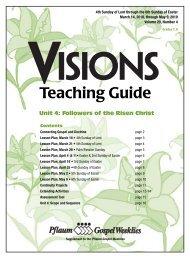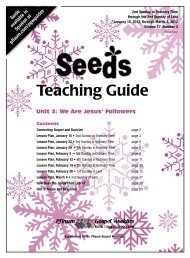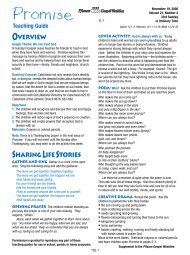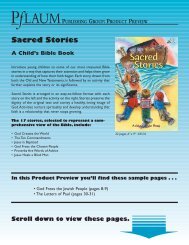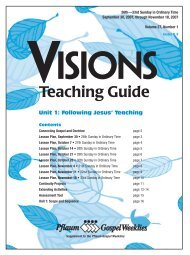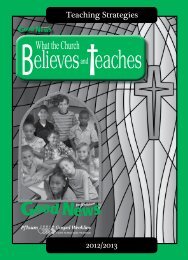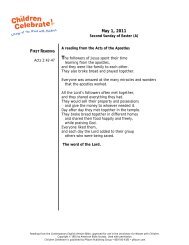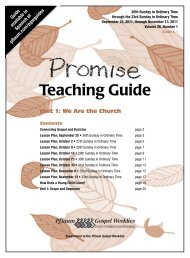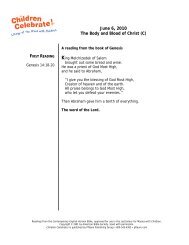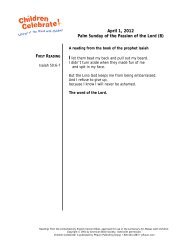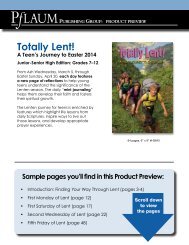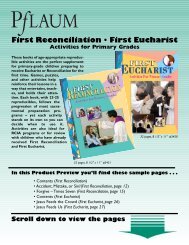Visions - Pflaum Home
Visions - Pflaum Home
Visions - Pflaum Home
Create successful ePaper yourself
Turn your PDF publications into a flip-book with our unique Google optimized e-Paper software.
Teaching Guide<br />
October 28, 2012 • 30th Sunday in Ordinary Time<br />
Jeremiah 31.7-9; Hebrews 5.1-6; Mark 10.46-52<br />
Gospel Theme: Christians<br />
call on Jesus with faith.<br />
In this Sunday’s Gospel the blind beggar Bartimaeus calls out<br />
to Jesus in faith before he sees Jesus with his eyes. He is the<br />
ideal disciple in Mark’s Gospel who follows Jesus as soon as<br />
he can see. <strong>Visions</strong> celebrates the 50th anniversary of the<br />
Second Vatican Council with the story of the council; its three<br />
main documents on the Liturgy, the Church, and the Church<br />
and World; and its renewing vision for Jesus’ followers in our<br />
world today. The issue includes a special anniversary treasury<br />
of Vatican II teachings from the three major council documents<br />
for the young people to assemble and complete.<br />
Share Our Life Stories<br />
Objective: The young people will explore the meanings of<br />
the word seeing.<br />
Opening Prayer/Cover: What is Seeing? Begin with your<br />
regular gathering ritual. Distribute <strong>Visions</strong>. As you play “What<br />
Is Our Service to Be?” from the <strong>Visions</strong> CD, have the young<br />
people look around the room to see people or things for which<br />
they are thankful. Afterward, invite them to mention what they<br />
are thankful for in prayer. For each person or thing mentioned,<br />
invite the group to respond, “Thank you, all-seeing God.”<br />
Objective: The young people will explore ways Vatican II<br />
continues to renew the Church.<br />
Article: What Happened at Vatican II? (pages 2-4) The<br />
photos under the title shows all the bishops assembled in St.<br />
Peter’s Basilica. Look closely at the icon of John XXIII and the<br />
words on the scroll he holds. Look at the photo and read the<br />
cutline about Paul VI. Read aloud the three key words and<br />
their definitions, page 3, upper right.<br />
• Invite volunteers to take turns reading the article aloud<br />
from one subtitle to the next. Discuss the TALK questions on<br />
page 3. Answers: 1. It changed the liturgy by creating a 3-<br />
year lectionary cycle; the priest now faces the congregation;<br />
the Mass is said in every community’s native language instead<br />
of Latin. It opened up dialogue between Catholics and other<br />
faiths. It connected the Church and the modern world.<br />
2. Both councils were about trying to create standards and<br />
unity in a changing Church in a changing world. The first<br />
council was about not keeping Jewish laws. The second<br />
council was about making the Church more accessible and up<br />
to date. 3. Open-ended. 4. Open-ended. 5. The Church<br />
cares about the well-being of the entire human race.<br />
6. Open-ended.<br />
WCBT, page 5-6, Believe. Read the introduction, which<br />
reminds students they belong to the Church. Nicaea is an<br />
example of another council, page 6.<br />
Listen to the Gospel<br />
Objective: The young people will connect seeing and<br />
believing.<br />
Gospel: Jesus Cures a Blind Man (page 4) Have three young<br />
people proclaim the Gospel dramatically while the rest of the<br />
class acts as the crowd who tries to quiet Bartimaeus. Discuss<br />
TALK. Answers: 1. Many people in Jesus’ time thought<br />
disabilities were signs of God’s disfavor or punishment; they<br />
might have thought a blind man was sinful and should stay away<br />
from a holy man like Jesus; they may have been ashamed of<br />
him or embarrassed that Bartimaeus called attention to himself.<br />
2. Bartimaeus recognizes Jesus as the Son of David and one<br />
who can heal his blindness. Faith helps us see people’s inner<br />
humanity, their values and individual qualities; faith sees what<br />
oneself or others can be and do. 3. Jesus sees a man asking<br />
for help who believes Jesus can indeed heal him. Jesus says<br />
Bartimaeus’s faith heals him.<br />
Definition: Discipleship (page 4) Have a volunteer read the<br />
definition to the class.<br />
Our Catholic Faith: We Speak With Jesus at Eucharist<br />
(page 5) Read this feature with the class. It connects the<br />
Gospel and the Eucharist. Jesus reaches out to us in the<br />
Eucharist as he once reached out to Bartimaeus. Hand out<br />
missals so the young people can find additional dialogs<br />
between priest and people.<br />
Build Christian Community<br />
Objective: The young people will explore key teachings<br />
from Vatican II.<br />
Living the Gospel: My Treasury of Teachings from Vatican<br />
II (pages 7-8) Have your students separate pages 7-8 from<br />
the issue, fold the page in half, cut along the fold, and nest<br />
booklet pages 4-5 inside pages 2 and 7, and fold in half to<br />
make the booklet. Have your young people work in threes or<br />
fours.<br />
• Open to booklet page 2-3, Liturgy. Ask the student<br />
what the visuals show is part of the liturgy. Explain liturgy is<br />
the public worship of the Church; it includes the sacraments,<br />
liturgical year, divine office, sacred music and art. Read aloud<br />
the four key quotations—how worship builds the Church,<br />
how we are an Easter people at our Baptisms, how we should<br />
participate actively in liturgy, and how Christ is present<br />
among us. Lead the young people in doing each activity.<br />
• Booklet page 4, Church. Talk about each image of<br />
Church. Have the students circle their favorite and share<br />
why. Read aloud the quotation about the Holy Spirit. Have<br />
the young people underline the verbs as you read. Talk about<br />
each verb and give examples.<br />
ALERT: THE GUIDE CONTINUES ON PAGE 12, COLUMN 1.<br />
TG1-8



